Finding the Best Bushcraft Knife for You
Apr 27 2021 - 12:09
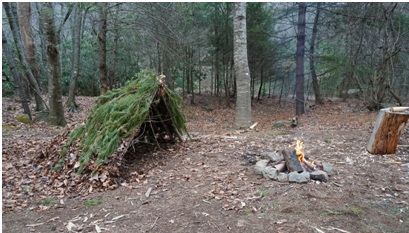
Spring is finally here and that means it is time to dust off your camping supplies and prepare to get out there and enjoy the great outdoors. For many outdoor enthusiasts, this is the perfect time to dial in their bushcraft skills. If you are interested in learning more about bushcraft or honing your own skills, finding the right knife for the task is crucial. Finding the best bushcraft knife can be difficult, especially when you consider how many different types of tasks fall under the idea of bushcraft.
Bushcraft
Bushcraft is the use and practice of skills related to wilderness survival. While a wide variety of activities can fall under the umbrella of bushcraft, most of these skills center around the ability to create or find shelter, fire, water, and food. These skills are extremely valuable, especially in survival scenarios. There are a wide range of different bushcraft tasks and you can easily spend a lifetime practicing bushcraft while still learning new skills every time you journey into the woods. There are a number of bushcraft skills that will require a good knife.
Shelter Building
Some of the most important bushcraft skills center around constructing shelters. What this means all depends on what you are trying to achieve. Some people who practice in the same location consistently may build a large semi permanent shelter, while others may just construct a shelter to provide warmth and protection for a single night.
The complexity of your shelter will determine the types of skills needed. Almost all shelters will require harvest and cutting wood. Different types of walls will require the use of leaves, earth, and other natural materials. Typically an entire bushcraft shelter can be constructed using only minimal tools. In some cases, a sturdy knife might be all that is needed to put together your entire shelter. For more complex shelters, shovels, saws, cordage, and other primitive tools may be needed.
Fire Making
Once shelter has been made, fire is usually a major bushcraft priority. The ability to create fire using friction is something of a rite of passage in the bushcraft community, as this primitive skill is essential for survival in a world without matches, lighters, or other firestarters. Many bushcraft knives feature a small divot in the handle designed to operate as the cap for the spindle of a bow drill for fire starting. Knives can also be used to cut and prepare the wood and tools needed to start a friction fire
Knives are also valuable tools when it comes to using firestarters. Using firestarters is it's own art, as an adequate tinder bundle has to be created and the rod has to be struck in the correct fashion. Ferro rods are consumable firestarters that have to be struck with a sharp surface to remove material and produce sparks. The sharp 90 degree spine of a knife is a great tool for this job. Using the blade of your knife should always be avoided, as it can damage both your knife and your ferro rod, potentially costing two valuable resources.
Food and Water
The final thing to consider when practicing your bushcraft skills is food and water. In many cases store bought filtration systems and purification tablets will provide the clean water needed. This means that a good knife won't be essential when it comes to sourcing water. When it comes to food, a knife is always an invaluable tool.
Many bushcraft fans will pack food for their trips so they do not have to deal with foraging, hunting, or trapping food on their trips. If you do plan on foraging, a knife can be used to dig roots or harvest plants. Even if you are bringing your own food with you, a good knife is essential for food prep and can make a great cooking tool.
Other Bushcraft Activities
Bushcraft is not all about surviving in the wilderness, it is about thriving there as well. To this end, many bushcraft practitioners take the time to embrace the craftier side of bushcraft. Once you have all of your essential needs covered, you can start building up your camp for the fun of it. This includes building practical devices like a water wheel powered spit, a clay furnace, or even just doing some relaxing whittling by the campfire. Having a knife that you can control is essential for performing tasks that require detailed cuts.
Choosing a Knife
There are a lot of different options when it comes to trying to find the best bushcraft knife. Some of it will come down to personal preference, but there are a few good guidelines to follow. Generally, a good bushcraft knife should have a full tang, fixed blade that is between 3.5 and 6.5 inches in length. The exact design and construction of the blade will ultimately come down to user preference, but spear point and drop point designs remain the most popular options.
Small Knives
Obviously smaller knives are going to be best suited for performing tasks where precision is essential. If you need a knife just for performing fine detailed tasks, a folding knife may even suffice. The main fault of folders is that they cannot handle extreme impacts like chopping and batoning. Despite this fact, if you need a compact knife for whittling or other fine tasks, having a folding knife or small fixed blade in your pocket or pack is never a bad idea. If you are looking for a small knife for your next bushcraft trip, here are a few options to consider
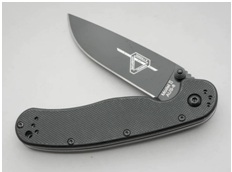
Ontario Rat Model II - The Rat II folding knife is a great little knife from the Ontario Knife Company. These no nonsense folders have a 3" drop point blade made from AUS-8 stainless steel. They are lightweight and make a great EDC knife or a backup blade for bushcraft. These knives are sturdy, built for hard work, and easy to work with. At only 4" closed, it is easy to throw the RAT II in your pocket or pack. The textured handles and jump jimping make these knives easy to open and control.
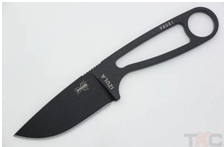
ESEE Izula B - The Izula B is a compact fixed blade knife from ESEE Knives. The Izula B has a 2 ⅝" drop point blade manufactured from 1095 carbon steel. These knives have a skeletonized handle that keeps them lightweight and thin, but they can be easily enhanced with a pair of our custom g10 handle scales. Each of these little knives comes with a plastic sheath for keeping your knife safe and secure in transit.
All Purpose Knives
If you are only planning on bringing one knife with you, then you will want to shoot for one in the 3.5 to 6.5 inch range. This sweet spot will provide the maximum utility. Typically you can either securely swing or chop when gripping from the handle, or choke up on the blade for performing more controlled actions. When it comes to choosing a great all around outdoors knife, we have a few recommendations.
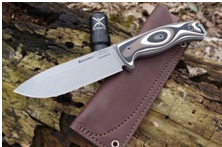
Architect Field Buddy 5.5 - The Field Buddy 5.5 is the result of years of work here at The Knife Connection. Dale, the founder of The Knife Connection, started to consider just what he would want in his ideal outdoor knife. The Field Buddy 5.5 is a real workhorse with a 5.5" blade constructed from 1095 carbon steel. These knives are built to perform and feature a skeletonized handle to reduce weight, thumb jimping to provide a secure grip, and jimping on the pommel to provide a striking surface. We stand by these knives with an unconditional lifetime warranty on the blade and handle.
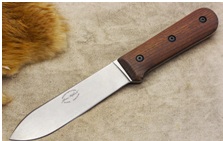
Becker BK62 Kephart - Named after American Woodcraft legend Horace Kephart, the Becker BK62 Kephart was modeled after the only known original Kephart knife in existence. The task of recreating this legendary knife was given to the team at KA-BAR and they did not disappoint. These knives have a 5 inch spear point blade constructed from 1095 Cro-Van steel, an alloy similar to 1095 carbon steel with the addition of a few other metals. The bolt on handle scales are made from walnut, giving the knife a classic look and feel. A forward taper on the blade handle makes it comfortable to choke up on. As a time tested design, you can rest assured that this knife was designed to provide everyone one needs to accomplish all their campsite tasks.
Other Tools
In addition to carrying a knife, many bushcrafters will also carry additional tools in order to ensure that they can handle any tasks they may encounter. Even the best bushcraft knife won't be up to every task the wilderness throws your way. Luckily, there are plenty of tools designed to handle tougher chopping work than your average knife. Typically bushcrafters will carry a machete, hatchet, or kukri if they need a larger chopping tool. We'll take a look at a great example of each of these tools.
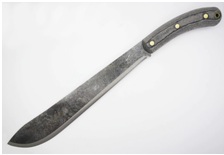
ESEE Knives Expat Darien - The Expat Darien is a rugged machete with a 12.38" blade and an 18.18" overall length. The 1075 carbon steel blade can handle a lot of abuse and is perfect for chopping and clearing foliage. The handles are made from wear resistant micarta to provide a comfortable grip. Each Expat Darien comes with a sturdy canvas and nylon sheath to keep your blade safe during transport.
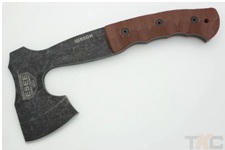
ESEE Knives Gibson Axe - The Gibson axe was designed by knifemaker James Gibson to be a compact axe ideal for throwing in a pack. This 10.5" hatchet has a 4.5" head with a 2.75" cutting edge. The body of the axe is made from 1095 steel and the handles are constructed from textured micarta to provide an excellent grip. The Gibson axe is well suited for carving tasks as well as light chopping.
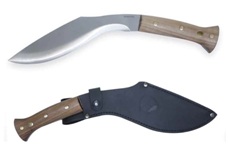
Condor Tool and Knife Heavy Duty Kukri Knife - Kukris have an interesting design that some people find extremely useful. The curved blade of a kukri can be used as a chopping implement or as a crude digging tool. The portion of the blade near the handle can also be used to perform fine cutting tasks. The Condor Tool and Knife Heavy Duty Kukri is 15" long with a 9" cutting edge. The blade is constructed from 1075 carbon steel and each of their kukris comes with a handmade leather sheath.
Our Survival Gear
If you are planning a bushcraft trip, a good knife is essential, but it should be far from the only piece of gear in your pack. Luckily when you are shopping to find the best bushcraft knife for you, it's easy to also pick up a few pieces of gear for your pack.
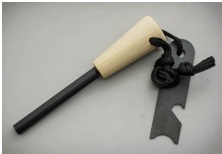
Architect Ferro Rod Firesteel with Striker - Ferro rods are one of the best firestarters to have in your pack. Ferrocerium is a special pyrophoric alloy. Pieces of ferrocerium ignite easily when heated by the friction of a strike against a hard surface. The action of using a ferro rod is similar to using a flint and steel. The main difference is that flint actually causes the iron in steel to ignite when striked, while the ferro rod is the consumed material when striking one. As long as you have a ferro rod, try tinder, and a knife with a sharp spine, firestarting should not be a challenge. Our Architect ferro rods are available with different handle designs so you can pick the perfect option for you.
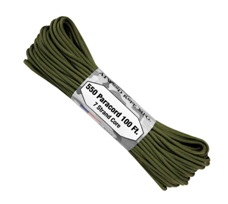
Atwood 550 Paracord - It's hard to think of a material that is more versatile than paracord. While it is always possible to make your own cordage from plant fibers, having some paracord on hand is a great way to speed things up when performing bushcraft tasks that require cordage. This paracord is made in the US and designed to perform. It can be used as is, or the inner core stands can be removed to create sewing thread or fishing lines. With a million uses and counting, you won't regret keeping some paracord in your bushcraft pack.
So before your next trip out to the wilderness, be sure to stock up on supplies here at The Knife Connection. Check out the Bushcraft Knives category of our store to see a list of quality knives and find the best bushcraft knife for you. If you have any questions about any of our products, feel free to reach out to one of our knife experts!